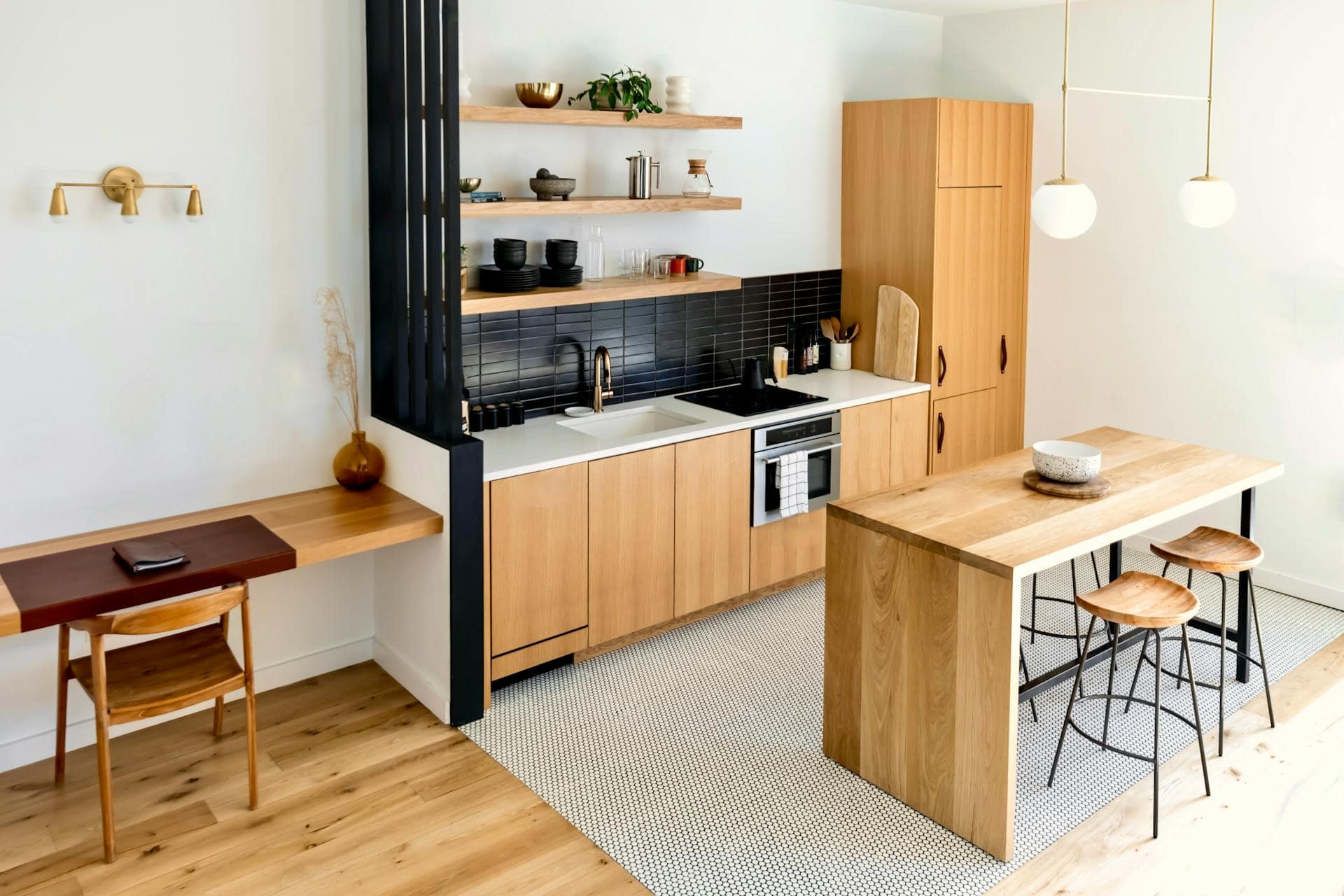Innovation is transforming the modern home, with kitchens becoming a focal point for technological progress and design evolution. From smart integrations to sustainable materials, homeowners are increasingly drawn to features that offer both style and substance.
Wooden kitchen worktops, once a hallmark of tradition, have embraced this shift. Advances in manufacturing, material science, and customisation have elevated wood from a classic surface to a forward-thinking choice. Today’s wooden worktops combine natural beauty with cutting-edge functionality, making them a smart and sustainable solution for contemporary kitchen design.
Exploring Wood Species: A Worktop for Every Style
Different species bring different moods to the kitchen. Choosing the right one is not just about appearance. It is about how the wood interacts with light, texture, cabinetry and even your cooking style.
Oak kitchen worktops are a perennial favourite for good reason. Their golden hues and natural grain add timeless appeal, while their impressive strength means they hold up well in busy households.
Walnut kitchen worktops bring depth and luxury to the space. With rich, dark tones and a flowing grain pattern, they are perfect for creating contrast in modern kitchens or adding gravitas to classic designs.
Iroko kitchen worktops are loved for their durability and deep colouring, which matures beautifully over time. Their natural oils help resist moisture, making them especially suited for high-use areas.
Maple kitchen worktops are light, bright and subtly grained. They are ideal for smaller kitchens or those aiming for a clean, airy aesthetic.
Sapele kitchen worktops stand out with their rich, reddish tones and distinctive interlocking grain, offering a dramatic foundation for bold interiors.
Ash kitchen worktops present a pale tone with caramel streaking, excellent shock resistance and a lovely blend of rustic and refined.
Cherry kitchen worktops provide a warm reddish tint that darkens with age, perfect for traditional kitchens or those seeking a classic English look.
Wenge kitchen worktops are bold and contemporary. Their dark, almost black colouring makes a dramatic statement, especially when paired with lighter cabinetry.
Beech kitchen worktops offer a gentle pinkish tone and a smooth, fine grain. They suit both classic and Scandinavian-inspired kitchens.
Each of these woods complements different interiors, from heritage-inspired to cutting-edge minimalism. Your choice ultimately comes down to the mood you want to create. Whether that is warm and welcoming, bold and modern, or something in between.
Innovation in Design: Customisation and Bespoke Solutions
Today, we expect more than off-the-shelf solutions. As kitchen layouts become more varied and personal, the demand for made-to-measure wood worktops continues to grow. This shift has brought precision craftsmanship to the forefront, allowing wood to meet the needs of contemporary living without losing its traditional charm.
A worktop cut to size service makes it easy to achieve a tailored finish. Whether you are dealing with unusual dimensions or want to incorporate a breakfast bar or island unit, having your worktop professionally sized can make all the difference.
Similarly, a hob cut out service enables seamless integration of appliances. The result is a more streamlined, considered look. It also means easier cleaning and improved functionality.
These bespoke services offer greater flexibility during planning and installation, helping you get the most from your chosen wood.
Sustainable Sourcing and Modern Manufacturing
Sustainability is no longer a trend; it is an essential part of responsible kitchen design. Fortunately, wooden worktops align naturally with eco-conscious values, especially when paired with modern technology and ethical sourcing practices.
Today’s manufacturers are embracing 21st-century advancements to minimise environmental impact at every stage of the process. CNC (Computer Numerical Control) machinery enables ultra-precise cutting, which reduces material waste and improves yield from each timber. Laser scanning and automated defect detection help identify the best parts of a board, allowing manufacturers to use wood more efficiently and avoid unnecessary offcuts.
Digital inventory and supply chain systems ensure that materials come from verified, responsibly managed forests. Most quality wooden worktops now use FSC®-certified timber, providing assurance that every piece has been harvested sustainably, with full traceability.
Even finishing techniques have evolved. Low-VOC and water-based sealants, applied using advanced spray systems, reduce harmful emissions and improve air quality in both production and homes. Some factories now run on renewable energy sources, further cutting their carbon footprint.
By combining traditional craftsmanship with cutting-edge technology, wooden worktop production is becoming more sustainable than ever while maintaining the high standards of quality and character that make wood so enduringly popular.
Functional Trends: Beyond the Surface
Wooden worktops have always been admired for their warmth and character, but modern innovations are pushing them well beyond their traditional role. No longer limited to visual appeal and tactile comfort, today’s wooden worktops are engineered to support the evolving demands of contemporary living.
Wireless Charging Pads Hidden Beneath the Surface
Modern charging pads can be discreetly installed under the worktop, allowing devices to charge wirelessly by simply resting them on the surface. The technology works through most hardwoods and helps reduce clutter, making it perfect for multipurpose kitchens.
Touch-Sensitive Controls and Smart Integration
Capacitive touch sensors can be embedded beneath the wood, turning your worktop into a control panel for lights, speakers, or appliances. These systems connect easily with smart home platforms and remove the need for external switches, keeping surfaces clean and intuitive.
Anti-Bacterial and Stain-Resistant Finishes
Advanced finishes now protect wooden worktops from bacteria, stains and moisture. These coatings are food-safe and nearly invisible, helping to preserve the natural appearance of the wood while making it easier to clean and maintain.
Whether incorporated into family kitchens, open-plan living spaces, or design-led interiors, these new features show how wooden worktops continue to evolve. They are now smarter, safer, and more adaptable than ever before, offering beauty with built-in intelligence.
Conclusion
Wooden worktops have come a long way from simple slabs of timber. Today, they are as much about innovation and individuality as they are about natural beauty. With the wealth of species available, the rise of customisation services, and increasing options for sustainability and technology, wooden worktops remain a firm favourite in British kitchens.
If you are planning a kitchen that combines style, practicality and a genuine connection to natural materials, it is well worth exploring the possibilities. From oak worktops to bespoke cut to size solutions, there has never been a better time to discover how a wooden worktop can truly shape your space.
Why wait, order your Solid wood worktop today!
We know wood, and because of this, we are able to offer you an expansive collection of wood worktops and services, to suit any and all home projects.



